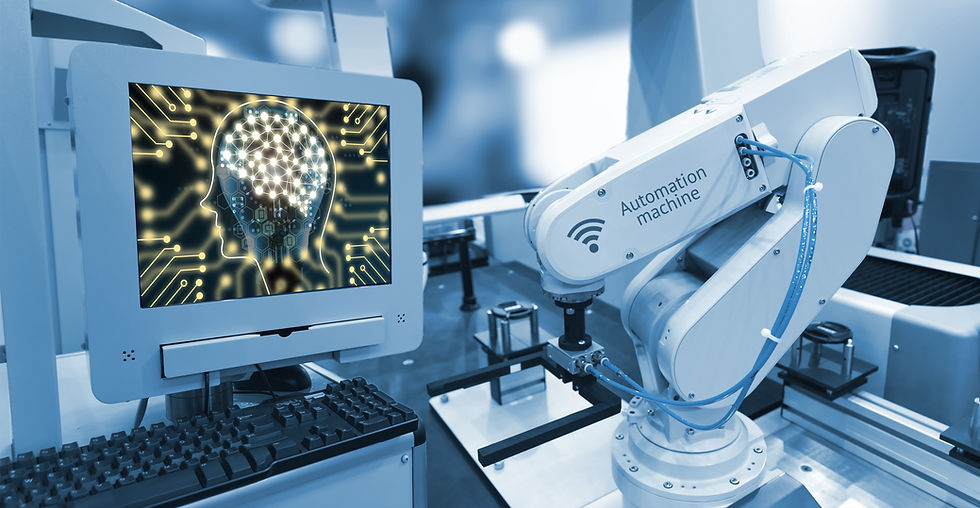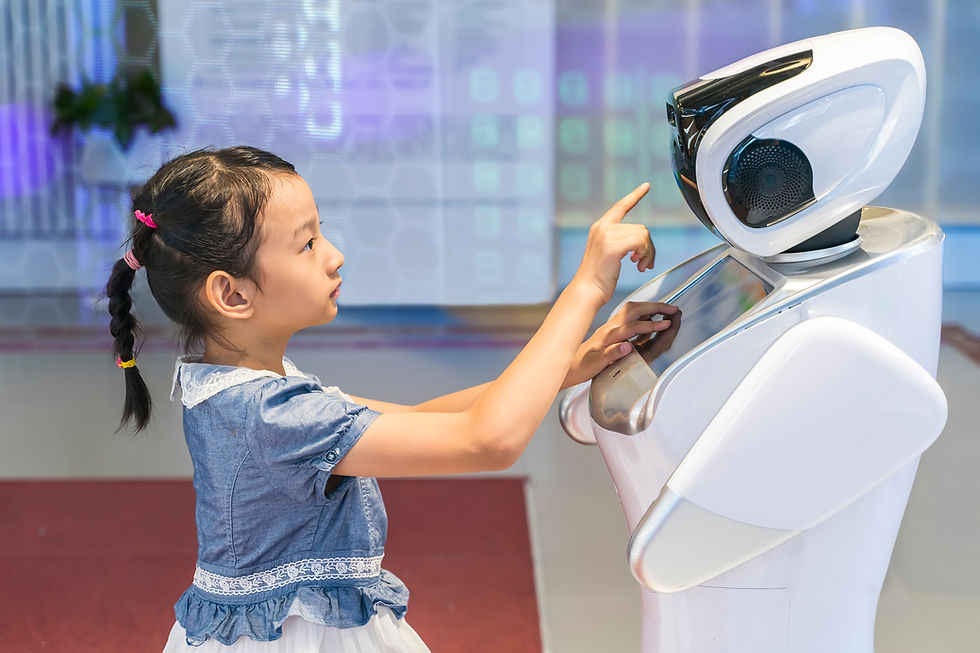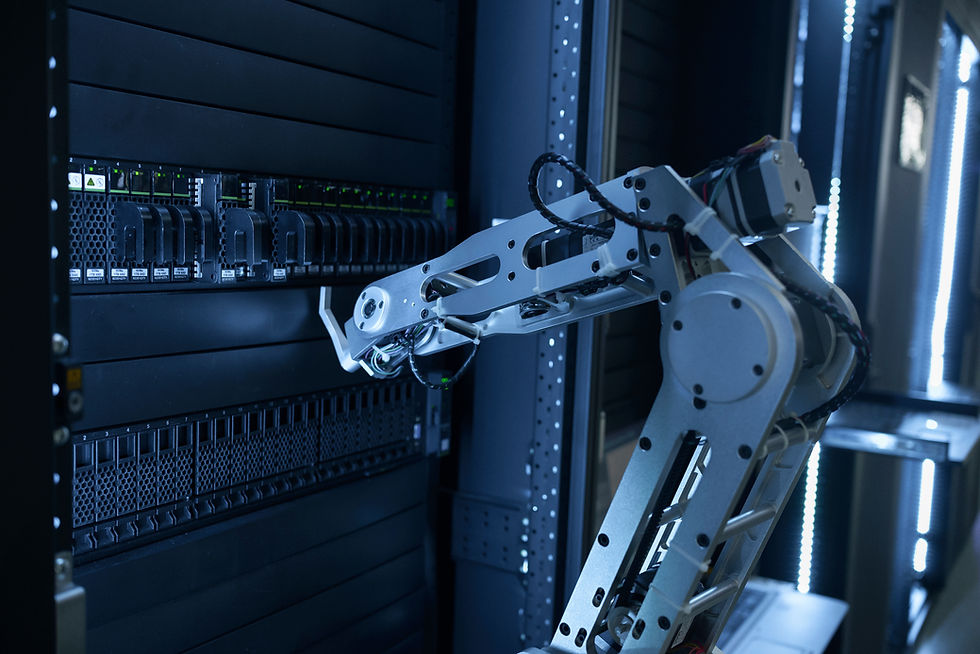Robotics:
- The Moolah Team
- Jun 23, 2023
- 13 min read
Advancements in Intelligent and Autonomous Systems.
Robotics is a field that involves the design, construction, and operation of robots.
From manufacturing to healthcare to space exploration, there are many exciting applications of robotics.
In this blog, we'll explore the latest developments in robotics and discuss the potential implications for our society and economy.
I. Introduction: Robotics: Advancements in Intelligent and Autonomous Systems
Robots have come a long way from their origins as simple machines that performed repetitive tasks in factories. Today, robots are becoming increasingly intelligent and autonomous, with the ability to learn, reason, and make decisions on their own. From self-driving cars to drones to robotic surgery, there are countless examples of the exciting applications of robotics.
Advancements in machine learning and artificial intelligence have played a significant role in the development of intelligent robots. Deep learning, reinforcement learning, and natural language processing are just a few of the many techniques that have revolutionized robotics in recent years. At the same time, advances in computer vision have made it possible for robots to "see" and interpret the world around them, enabling them to perform tasks that were once thought to be the exclusive domain of humans.
But what are the potential implications of these advancements for our society and economy? As robots become more intelligent and autonomous, they are likely to have a profound impact on the job market, on our safety and security, and on accessibility and inclusivity. It is crucial that we explore these implications and consider the responsible and ethical deployment of robotics.
In this blog post, we'll take a deep dive into the latest developments in robotics and examine their potential implications for our society and economy. We'll look at advancements in both intelligent and autonomous systems, exploring the exciting new technologies that are shaping the future of robotics. We'll also consider the challenges and opportunities that lie ahead, and we'll offer our thoughts on the responsible and ethical deployment of robotics.
So buckle up and get ready to explore the exciting world of robotics. From self-driving cars to drones to robotic surgery, there's a lot to discover!

II. Advancements in Intelligent Systems: Machine Learning and Computer Vision
Advancements in machine learning and computer vision have led to some of the most exciting developments in the field of robotics. Machine learning is a subfield of artificial intelligence that focuses on the development of algorithms that can learn from and make predictions based on data. Computer vision, on the other hand, is concerned with enabling machines to interpret and understand the visual world.
A. Machine Learning and Artificial Intelligence
Deep Learning
Deep learning is a type of machine learning that is inspired by the structure and function of the human brain. It involves training artificial neural networks with large amounts of data, allowing the networks to learn complex patterns and make predictions with a high degree of accuracy. Deep learning has been applied to a wide range of robotics applications, from object recognition to natural language processing.
Reinforcement Learning
Reinforcement learning is a type of machine learning that involves training agents to interact with an environment and learn from feedback in the form of rewards or penalties. This approach has been used to train robots to perform tasks such as grasping and manipulation, as well as to play games such as chess and Go.
Natural Language Processing
Natural language processing (NLP) is a subfield of artificial intelligence that focuses on enabling machines to understand and generate human language. NLP has many applications in robotics, including voice recognition, chatbots, and translation.
B. Computer Vision
Object Recognition
Object recognition is the ability of a machine to identify and locate objects in an image or video. This technology has been applied to robotics applications such as autonomous navigation, surveillance, and quality control in manufacturing.
Image and Video Processing
Image and video processing involves the manipulation and analysis of visual data. This technology has been used in robotics for tasks such as detecting anomalies in manufacturing processes, monitoring crops in agriculture, and identifying defects in infrastructure such as bridges and roads.
Autonomous Navigation
Autonomous navigation involves enabling machines to navigate and interact with their environment without human intervention. This technology has been used in robotics applications such as self-driving cars, drones, and mobile robots for tasks such as delivery and logistics.
Overall, advancements in intelligent systems have led to a wide range of exciting applications in robotics. From deep learning to natural language processing to computer vision, there are countless examples of how these technologies are being used to create intelligent and autonomous machines.

III. Advancements in Autonomous Systems: Robotics and Self-Driving Vehicles
Advancements in autonomous systems have revolutionized the way we interact with machines. From self-driving cars to drones to robots, these technologies have the potential to transform a wide range of industries. In this section, we'll explore some of the latest developments in autonomous systems and their implications for our society and economy.
A. Robotics
Collaborative Robots
Collaborative robots, also known as cobots, are designed to work alongside humans in a shared workspace. These robots are equipped with sensors and safety features that allow them to operate safely and efficiently in close proximity to humans. They are being used in manufacturing, healthcare, and other industries to perform tasks such as assembly, inspection, and logistics.
Exoskeletons
Exoskeletons are wearable robots that can augment human strength and mobility. They have applications in industries such as construction, manufacturing, and healthcare, where they can help reduce the risk of injuries and improve productivity.
Soft Robotics
Soft robotics is a field that focuses on the development of robots made from soft, flexible materials. These robots are designed to be adaptable and able to move through complex environments. They have applications in industries such as agriculture, where they can be used to pick and sort delicate fruits and vegetables.
B. Self-Driving Vehicles
Autonomous Cars
Autonomous cars are vehicles that are able to navigate and operate without human intervention. They use a combination of sensors, cameras, and machine learning algorithms to perceive their environment and make decisions. Self-driving cars have the potential to greatly reduce traffic accidents and improve transportation efficiency.
Autonomous Trucks
Autonomous trucks are being developed for use in the shipping and logistics industry. These vehicles have the potential to greatly reduce transportation costs and improve delivery times. They also have applications in industries such as mining and construction, where they can be used to transport heavy loads.
Drones
Drones are unmanned aerial vehicles that are being used in a wide range of applications, from military surveillance to agricultural monitoring to search and rescue operations. They have the potential to greatly improve efficiency and safety in many industries.
Overall, advancements in autonomous systems have the potential to transform a wide range of industries and improve efficiency, safety, and productivity. From collaborative robots to self-driving vehicles to drones, these technologies are rapidly advancing and opening up new possibilities for the future.

IV. Implications of Robotics and Autonomous Systems
While the advancements in robotics and autonomous systems have the potential to revolutionize many industries, they also raise important questions about their impact on society and the economy. In this section, we'll explore some of the potential implications of these technologies and their role in shaping our future.
A. Job Displacement
One of the most pressing concerns about robotics and autonomous systems is the potential for job displacement. As machines become increasingly capable of performing tasks that were previously done by humans, many workers may find themselves out of work. This could have a significant impact on the economy, as well as on individual workers and their families.
However, some experts argue that robotics and automation could actually create new jobs and opportunities, particularly in industries such as engineering and technology. Additionally, these technologies may be able to help address labour shortages in certain industries, such as healthcare and agriculture.
B. Privacy and Security
Another concern about robotics and autonomous systems is their potential impact on privacy and security. As these technologies become more prevalent, they may collect and store large amounts of data about individuals, raising questions about who has access to this data and how it is used.
Additionally, there are concerns about the security of these systems. If they are not properly secured, they could be vulnerable to cyber attacks or other forms of malicious behavior. This could have serious consequences, particularly if these technologies are used in critical industries such as healthcare or transportation.
C. Ethical Considerations
As robotics and autonomous systems become more advanced, they raise important ethical considerations. For example, there may be questions about the extent to which these technologies should be allowed to make decisions on their own, without human intervention.
There are also concerns about the potential for these technologies to be used in harmful or unethical ways. For example, autonomous weapons could be used to carry out military operations without human oversight, raising questions about accountability and the potential for unintended consequences.
D. Social and Economic Inequality
Finally, there are concerns about the potential for robotics and autonomous systems to exacerbate social and economic inequality. If these technologies are primarily developed and deployed by a small group of companies and individuals, they could reinforce existing power imbalances and contribute to a widening wealth gap.
Additionally, there may be concerns about the accessibility of these technologies. If they are only available to a small group of wealthy individuals or companies, this could further entrench inequality and limit opportunities for others.
Overall, while robotics and autonomous systems offer many exciting possibilities for the future, they also raise important questions and concerns about their potential impact on society and the economy. As these technologies continue to advance, it will be important to carefully consider their implications and ensure that they are developed and deployed in a responsible and equitable way.

V. The Future of Robotics and Autonomous Systems
As we've seen, the field of robotics and autonomous systems has come a long way in recent years. From manufacturing to healthcare to space exploration, these technologies have already had a significant impact on many industries. But what does the future hold? In this section, we'll explore some of the exciting possibilities for robotics and autonomous systems in the years ahead.
A. Advancements in AI and Machine Learning
One of the key drivers of progress in robotics and autonomous systems is the ongoing advancements in artificial intelligence (AI) and machine learning. As these technologies continue to improve, robots and other autonomous systems will become more capable and adaptable, with the ability to learn and make decisions in real-time.
This could have a significant impact on a wide range of industries, from transportation to manufacturing to healthcare. For example, self-driving cars could become safer and more efficient, while robots in factories could become more flexible and better able to handle complex tasks.
B. Integration with the Internet of Things
Another key trend in the future of robotics and autonomous systems is the integration with the Internet of Things (IoT). As more and more devices become connected to the internet, robots and other autonomous systems will be able to communicate with each other and share data in real-time.
This could enable new possibilities for collaboration and coordination, particularly in industries such as transportation and logistics. For example, self-driving cars could communicate with traffic lights and other vehicles to optimize traffic flow and reduce congestion.
C. Expansion into New Industries
As robotics and autonomous systems become more advanced and capable, they are also likely to expand into new industries and applications. For example, we may see more widespread use of robots and autonomous systems in industries such as construction, agriculture, and mining.
Additionally, these technologies may also have a significant impact on healthcare, with the potential to revolutionize the way we approach diagnosis and treatment. For example, robots could be used to perform complex surgeries with greater precision and accuracy, while autonomous systems could be used to monitor patients and detect health issues in real-time.
D. Collaboration with Humans
Finally, as robotics and autonomous systems become more advanced, they are also likely to become more collaborative with humans. Rather than replacing human workers, these technologies could work alongside them, leveraging their unique strengths and abilities to achieve even greater outcomes.
For example, robots and autonomous systems could be used to augment human decision-making in fields such as finance and law, helping to identify patterns and make recommendations based on large amounts of data.
Overall, the future of robotics and autonomous systems is full of exciting possibilities. As these technologies continue to advance and evolve, they have the potential to transform many aspects of our lives, from the way we work to the way we receive healthcare. It will be important to continue to explore and develop these technologies in a responsible and ethical way, to ensure that they benefit society as a whole.

VI. Implications for Society and the Economy
As robotics technology continues to advance, its impact on society and the economy becomes increasingly significant.
Here are some of the ways in which robotics is already changing our world, and what we can expect in the future:
A. Job Displacement
One of the most significant implications of robotics for the economy is the potential displacement of human workers. As robots become more advanced and affordable, they are increasingly being used to replace human workers in a variety of industries, from manufacturing to healthcare to transportation.
This trend has already begun in many industries, and is expected to continue in the coming years. While some argue that robots will create new jobs to replace those lost, others are concerned that the pace of automation may be too rapid for displaced workers to find new employment.
B. Increased Efficiency and Productivity
On the positive side, robotics technology has the potential to significantly increase efficiency and productivity in many industries. Robots are capable of performing repetitive tasks faster and more accurately than humans, and can work around the clock without the need for breaks or rest.
This increased efficiency can lead to lower costs for businesses, which can be passed on to consumers in the form of lower prices. It can also enable businesses to produce goods and services more quickly and on a larger scale, potentially leading to increased economic growth.
C. Improved Safety and Quality
Robotics technology has the potential to improve safety and quality in a variety of industries. For example, robots can be used to perform dangerous or hazardous tasks, such as working in nuclear power plants or exploring outer space.
In addition, robots can perform tasks with a level of precision and consistency that is difficult to achieve with human labour. This can lead to higher quality products and services, as well as reduced waste and errors.
D. Ethical and Social Considerations
As with any new technology, there are ethical and social considerations to be addressed with robotics. For example, there are concerns about the potential for robots to be used for unethical purposes, such as surveillance or military applications.
There are also questions about the impact of robotics on human relationships and social interactions. As robots become more advanced, it is possible that they could replace some human interactions, such as those between healthcare providers and patients or teachers and students.
E. Regulatory and Legal Issues
As robotics technology becomes more advanced and widespread, there will be a need for regulatory and legal frameworks to govern its use. For example, there may be questions about liability in cases where robots cause harm or damage.
In addition, there may be questions about intellectual property and ownership of the software and data used to operate robots. As robotics technology becomes more integrated into our lives, it will be important to establish clear guidelines and regulations to ensure its safe and ethical use.
Overall, the implications of robotics for society and the economy are complex and multifaceted. While robotics technology has the potential to bring many benefits, it also poses significant challenges and risks. It will be important for policymakers, businesses, and individuals to work together to navigate these issues and ensure that the benefits of robotics are shared widely and equitably.

VII. Ethical Considerations in Robotics
As we continue to make strides in the development of intelligent and autonomous systems, it's important to also consider the ethical implications of such advancements. Robotics has the potential to greatly benefit society, but it also poses new ethical challenges that we must address.
A. Impacts on Employment
One of the major ethical considerations in robotics is the impact on employment. As robots become more advanced and capable of performing tasks previously done by humans, there is a risk of job displacement. This can have a significant impact on individuals and communities who rely on these jobs for their livelihood.
It's important for us to consider how we can mitigate the negative impacts of automation on employment. This may involve retraining programs and other initiatives to help displaced workers transition to new careers. It's also important to ensure that the benefits of increased productivity and efficiency from automation are shared fairly among all members of society.
B. Bias and Discrimination
Another ethical consideration in robotics is the potential for bias and discrimination. As intelligent and autonomous systems become more prevalent in our society, there is a risk of perpetuating or even exacerbating existing biases and discrimination.
For example, facial recognition technology has been shown to have higher error rates for people with darker skin tones, which can have serious consequences in areas such as law enforcement. It's important for us to develop and implement ethical standards for the development and use of such technologies to ensure they are fair and unbiased.
C. Privacy and Security
The increasing use of robotics and intelligent systems also raises concerns around privacy and security. As these systems collect and process vast amounts of data, there is a risk of that data being misused or exploited.
It's important for us to establish strong privacy and security protections to ensure that individuals' personal information is not improperly used or disclosed. This may involve developing new regulations and standards for data collection, storage, and use, as well as investing in cybersecurity measures to prevent data breaches and other security incidents.
D. Autonomy and Responsibility
As we develop more autonomous and intelligent systems, we must also consider the issue of responsibility. Who is accountable when an autonomous system makes a mistake or causes harm?
This is a complex issue that requires careful consideration and discussion. It may involve developing new legal frameworks to clarify the responsibilities and liabilities of manufacturers, operators, and other stakeholders involved in the development and deployment of autonomous systems.
Conclusion
Robotics has the potential to bring about many exciting advancements in fields such as healthcare, manufacturing, and space exploration. However, it's important for us to consider the ethical implications of these advancements and work to address them proactively.
By developing and implementing ethical standards and regulations, investing in retraining and support programs for displaced workers, and fostering discussion and collaboration around these issues, we can ensure that the benefits of robotics are shared equitably and responsibly.

VIII. Conclusion: The Future of Robotics
As we've seen, robotics is an exciting and rapidly advancing field with a wide range of applications. From manufacturing to healthcare to space exploration, robots are already playing a crucial role in many industries, and this is only set to increase in the future.
One of the most exciting aspects of robotics is the potential for intelligent and autonomous systems. With the development of advanced AI algorithms and sensor technology, robots are becoming increasingly capable of making decisions and carrying out tasks without human intervention. This has the potential to revolutionize many industries and transform the way we live and work.
However, there are also significant challenges and potential risks associated with the increasing use of robotics. As robots become more autonomous and capable of making decisions on their own, there is a risk that they could be used in ways that are harmful to humans or the environment. There are also concerns around the impact of robotics on employment and the economy, as many jobs that are currently done by humans could be replaced by robots.
Overall, the future of robotics is both exciting and uncertain. While there are undoubtedly risks and challenges associated with the increasing use of robots, there is also the potential for enormous benefits in terms of efficiency, safety, and convenience. As we move forward, it will be important to carefully consider the implications of robotics and to ensure that they are developed and used in a way that benefits society as a whole.
Thanks for reading! We hope you found this blog post informative and insightful. Robotics is an incredibly exciting field with enormous potential for the future. From manufacturing to healthcare to space exploration, robots are already transforming many industries and opening up new possibilities for what we can achieve. If you enjoyed this post, be sure to subscribe to our newsletter to stay up-to-date with the latest developments in robotics and other exciting technologies. Thanks again for reading, and we'll see you in the next post!
Thanks a million,
Moolah







Comments